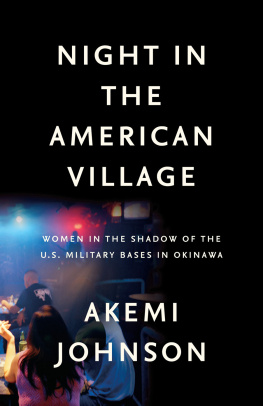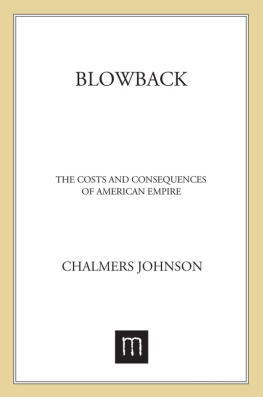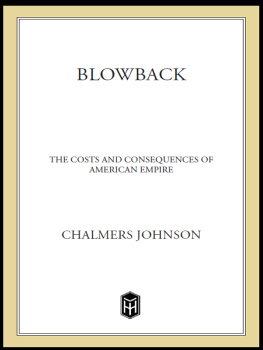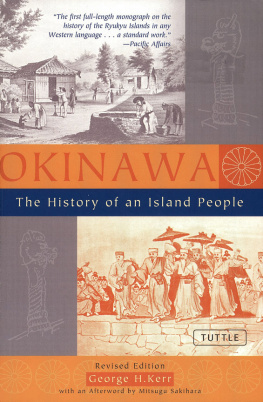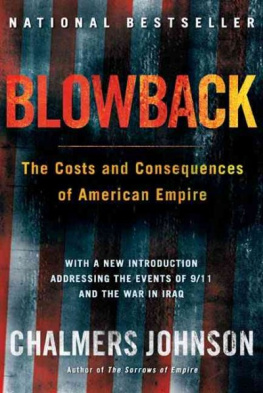Akemi Johnson - Night in the American Village: Women in the Shadow of the U.S. Military Bases in Okinawa
Here you can read online Akemi Johnson - Night in the American Village: Women in the Shadow of the U.S. Military Bases in Okinawa full text of the book (entire story) in english for free. Download pdf and epub, get meaning, cover and reviews about this ebook. year: 2019, publisher: The New Press, genre: Art. Description of the work, (preface) as well as reviews are available. Best literature library LitArk.com created for fans of good reading and offers a wide selection of genres:
Romance novel
Science fiction
Adventure
Detective
Science
History
Home and family
Prose
Art
Politics
Computer
Non-fiction
Religion
Business
Children
Humor
Choose a favorite category and find really read worthwhile books. Enjoy immersion in the world of imagination, feel the emotions of the characters or learn something new for yourself, make an fascinating discovery.
- Book:Night in the American Village: Women in the Shadow of the U.S. Military Bases in Okinawa
- Author:
- Publisher:The New Press
- Genre:
- Year:2019
- Rating:3 / 5
- Favourites:Add to favourites
- Your mark:
- 60
- 1
- 2
- 3
- 4
- 5
Night in the American Village: Women in the Shadow of the U.S. Military Bases in Okinawa: summary, description and annotation
We offer to read an annotation, description, summary or preface (depends on what the author of the book "Night in the American Village: Women in the Shadow of the U.S. Military Bases in Okinawa" wrote himself). If you haven't found the necessary information about the book — write in the comments, we will try to find it.
Akemi Johnson: author's other books
Who wrote Night in the American Village: Women in the Shadow of the U.S. Military Bases in Okinawa? Find out the surname, the name of the author of the book and a list of all author's works by series.
Night in the American Village: Women in the Shadow of the U.S. Military Bases in Okinawa — read online for free the complete book (whole text) full work
Below is the text of the book, divided by pages. System saving the place of the last page read, allows you to conveniently read the book "Night in the American Village: Women in the Shadow of the U.S. Military Bases in Okinawa" online for free, without having to search again every time where you left off. Put a bookmark, and you can go to the page where you finished reading at any time.
Font size:
Interval:
Bookmark:
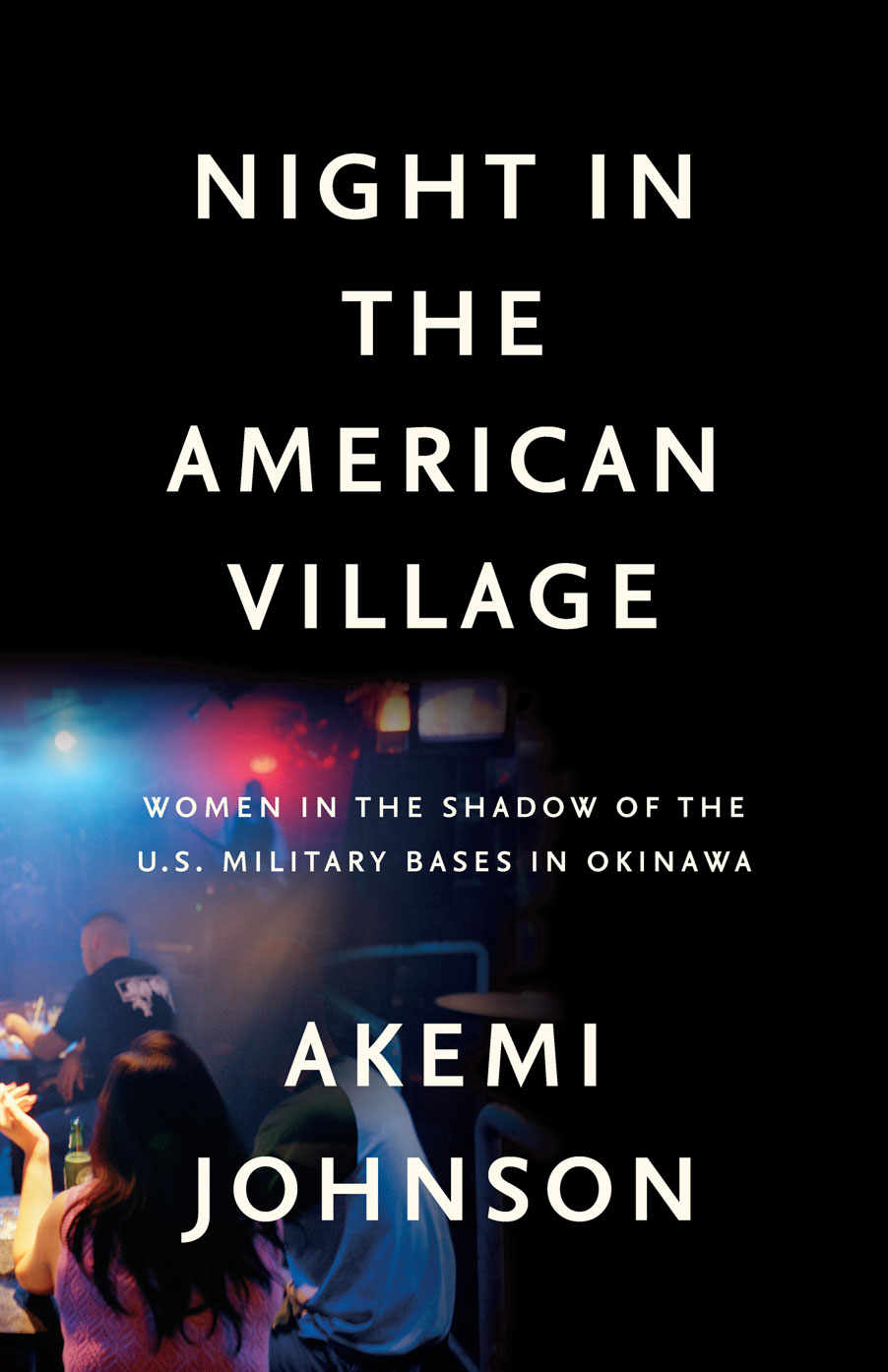

NIGHT IN THE AMERICAN VILLAGE
NIGHT IN THE AMERICAN VILLAGE

WOMEN IN THE SHADOW OF THE U.S. MILITARY BASES IN OKINAWA
AKEMI JOHNSON

For Nadine and Nick
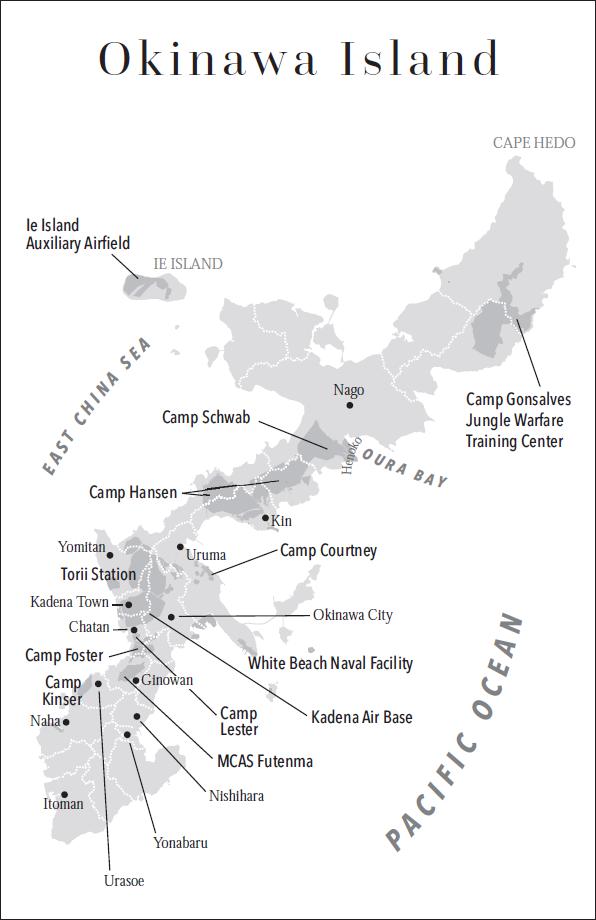

A YEAR AFTER HER DEATH, PEOPLE STILL BROUGHT HER FLOWERS. A makeshift memorial had been set up near the place where they had found her body, on the side of a twisting two-lane road in Onna Village. The road, flanked by dense forest, hugged the back of a luxury golf resort. On the bright afternoon I visited, the air smelled clean, and the area was quiet except for the wind in the trees, the occasional truck on the road, and the calling of crows.
The memorial stood in a clearing beside a path leading into the woods. Someone had brought a table, and people had filled the table with gifts. There were orchids and coins, cans of soda, bottles of tea, and glasses of water. There were bouquets of daisies and the red hibiscuses that grow everywhere on Okinawa, along with an alarm clock, a Christmas trinket, and potted houseplants. A stuffed Snoopy, clutching a red heart (I LOVE YOU!), had fallen to the ground and lay, looking forlorn, next to some cans of coffee. Beside the table, someone had built a little structure out of bricks to house a pot of incense. Rain on Okinawa can come on suddenly and with great intensity, followed by searing sun. The whole tableau was soggy, faded, softened by the elements. But there were fresh flowers, too. People had come very recently.
Soon after my visit, on the anniversary of her death, two more tables would be brought in to hold the dozens of bouquets, wrapped in cellophane, that people would bring. One activist would tweet a photo of the bunch she was leavingas pink and perfect as a bridesmaids bouquet. Even with the added tables, the flowers and drinks would spill to the ground.
I walked beyond the table toward the edge of the woods. Okinawa is a subtropical island where plants thrive. In cities, vines creep up the sides of buildings and weeds sprout on rooftops. In the northern forests, infinite shapes of green crowd together at all heightslow ferns, waving grasses, giant heart-shaped leaves, towering trees whose tops are said to look like broccoli. Here, the forest had been cut back. Cleared branches were piled beneath the roots of a felled tree. Yellow and black police tape wound around the trunk of another tree amid a riot of ferns. The path continued, but a wire fence blocked me from going further. Beyond the fence, people had discarded things: cinderblocks and boxes, a television set.
Walking back to my car, I noticed a sticker on a telephone pole near the memorial. It read, in English,
NO RAPE
NO BASE
NO TEARS

The island of Okinawa is long and skinny, about seven by seventy miles. The capital city, Naha, is in the south, with another large city, Nago, in the north. Its the main island of Okinawa Prefecture, the southernmost region of Japan. The chain of 160 small islands, most uninhabited, arcs between Kyushu and Taiwan, on the border between the Pacific and the East China Sea. At the northern tip of Okinawa Island, Cape Hedo, you can stand on the rocky ledge and watch the two oceans collide, the currents swirling and churning in teal and sapphire.
Often, the shorthand I use to describe Okinawa to Americans is the Hawaii of Japan. This is because the chain of islands is far awaygeographically, culturally, historicallyfrom the rest of the country; because the islands were an independent kingdom taken over in the 1800s, a monarchy deposed; because the place is achingly beautiful, home to the turquoise and white beaches of postcards; because that beauty has turned the islands into a tourist mecca, its indigenous culture reduced and wielded for profit; because in recent years the indigenous culture and language have resurged, with local people working to revive what the government tried to erase; and because Okinawa has been made to house, depending on whom you ask, too many or too few U.S. military bases.
Okinawa hosts more U.S. military bases than anywhere else in Japanthe country that hosts more U.S. servicemembers than anywhere else in the world. These bases have their genesis in the tail end of World War II, when American forces landed on the islands beaches and, amid the nightmarish battle that ensued, started constructing runways in preparation for an invasion of mainland Japan that never came. After the Allied victory, the U.S. military occupied Japan for seven years, instituting a peace constitution that decreed the country would not remilitarize. Article 9 states that land, sea, and air forces, as well as other war potential, will never be maintained. The 1952 Peace Treaty ended the occupation, and in 1954 American and Japanese leaders signed the U.S.Japan Mutual Security Treaty, the start of the bilateral security alliance. Japan, without a military, would receive protection under the U.S. military umbrella. In return, Japan would host U.S. bases.
Today, Tokyo pays billions of dollars of the annual costs of U.S. military bases in Japan, to the point where the United States covers little more than troops salaries. While most countries receive money from the United States to host bases, Japan and other affluent but once-occupied nations with a tradition of bearing American burdens, as scholar Kent Calder puts it, pay the United States. These nations include Germany and South Korea, with Japan consistently paying the most. Tokyos so-called sympathy payments are a great financial incentive for the United States to maintain bases in Japan, even if some have suggested otherwise. Presidential candidate and later president Donald Trump has repeatedly called on Japan to pay more for U.S. military bases.
American bases in Japan became concentrated in Okinawa because the 1952 Peace Treaty restored only the mainlands sovereignty. The U.S. military won continued rule of Okinawa, and over the next decade bases closed on the mainland and multiplied in Okinawa, where the U.S. military enjoyed total control. During the Cold War, as the United States built up its network of overseas bases, American soldiers seized Okinawans land by bulldozer and bayonet, displacing thousands of people to construct sprawling military facilities. Okinawa reverted to Japanese control in 1972, but, in what many consider a great injustice, the mainland didnt take back its share of bases. There are large bases in mainland Japan, like Yokota Air Base and Yokosuka Naval Base, both in the Tokyo region, and bases in Okinawa have been reduced since their peak, with some land being returned. But 70 percent of all bases in the country are still crowded in tiny Okinawa, mostly on the main island. They add about 50,000 American military personnel, civilian contractors, and family members to the islands population of 1.4 million. All four branches of servicethe marine corps, army, navy, and air forcehave a presence on Okinawa, with the marines making up the majority. The highest concentration of marine corps units in the IndoAsia Pacific region is on Okinawa. Many anti-base activists focus on getting marines off the island because of their large numbers and because, activists argue, the marines presence doesnt serve a real strategic purpose.
Font size:
Interval:
Bookmark:
Similar books «Night in the American Village: Women in the Shadow of the U.S. Military Bases in Okinawa»
Look at similar books to Night in the American Village: Women in the Shadow of the U.S. Military Bases in Okinawa. We have selected literature similar in name and meaning in the hope of providing readers with more options to find new, interesting, not yet read works.
Discussion, reviews of the book Night in the American Village: Women in the Shadow of the U.S. Military Bases in Okinawa and just readers' own opinions. Leave your comments, write what you think about the work, its meaning or the main characters. Specify what exactly you liked and what you didn't like, and why you think so.

